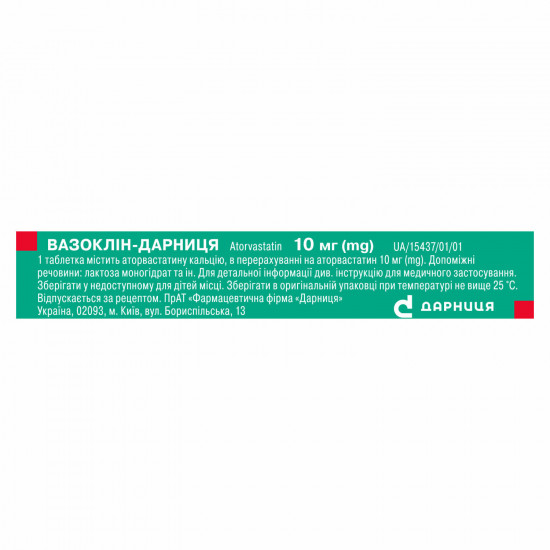





- Stock: In Stock
- Model: 182149
0% Customers recommend this product
-
5 Awesome0%
-
4 Great0%
-
3 Average0%
-
2 Bad0%
-
1 Poor0%
Reviews Over Vazoklin of the tab. of p/o of 10 mg No. 28
- (0)
Total Reviews (0)
click here write review to add review for this product.
Report this review.
Description
Pharmacological properties
Pharmacodynamics. atorvastatin represents synthetic hypolipidemic medicine. atorvastatin is inhibitor of a 3-hydroxy-3-methylglutaryl-coenzyme and (gmg-co) - reductases. this enzyme catalyzes transformation of a gmg-co in mevalonat — an early stage of biosynthesis hs which limits the speed of its education.
Atorvastatin is a selection competitive inhibitor of GMG-KoA-reduktazy, enzyme on which the speed of transformation GMG-KoA in mevalonat depends substance — the predecessor of sterols, including XC. XC and TG circulate in a blood-groove in a complex with lipoproteins. These complexes are divided by means of ultracentrifugation into LPVP, LPPP fractions (lipoproteins of intermediate density), LDL and LPONP. TG and XC in a liver are included LPONP and are released in blood plasma for transportation in peripheral fabrics. Are formed by LDL of LPONP and catabolize by interaction with high-affine receptors of LDL. Clinical and pathoanatomical trials show that the increased levels of the general XC, XC LDL and apolipoprotein B in blood plasma lead to developing of atherosclerosis at the person and are risk factors for development of cardiovascular diseases while the increased LPVP levels XC are connected with reduced risk of cardiovascular diseases.
In experimental models at animals atorvastatin is reduced by level XC and lipoproteins in blood plasma by inhibition in a liver of GMG-KoA-reduktazy and synthesis of XC and also by increase in number of hepatic receptors of LDL at surfaces of cells for strengthening of absorption and catabolism of LDL; atorvastatin reduces production of LDL and quantity of these particles. Atorvastatin reduces the LDL level XC at some patients with a homozygous family hypercholesterolemia, that is groups of people who seldom respond to treatment with other hypolipidemic medicines.
data that the increased levels of the general XC, XC LDL and apolipoprotein B (a membrane complex for the XC LDL) provoke development of atherosclerosis Are available. Thus, the LPVP reduced levels XC (and its transport complex — apolipoprotein A) are connected with development of atherosclerosis. It is known that the cardiovascular incidence and lethality change in direct ratio to the level of the general XC and XC LDL and in inverse proportion to the LPVP level XC.
Atorvastatin reduces levels of the general XC, XC LDL and apolipoprotein B at patients with a homozygous and heterozygous family hypercholesterolemia, single forms of a hypercholesterolemia and the mixed dislipidemiya. Atorvastatin also reduces levels XC of LPONP and TG and also causes unstable increase in the LPVP level XC and A-1 apolipoprotein. Atorvastatin reduces the level of the general XC, XC LDL, the XC LPONP, apolipoprotein V, TG and XC ne-LPVP and also increases the LPVP level XC at patients with the isolated gipertriglitseridemiya. Atorvastatin reduces the XC LPPP at patients with a disbetalipoproteinemiya.
toIt is similar to LDL the lipoproteins enriched with XC and TG including LPONP, LPPP and the remains, can also contribute to the development of atherosclerosis. The increased TG levels in blood plasma often appear in a triad with the LPVP low levels XC and small particles of LDL and also in combination with nonlipid metabolic risk factors of development of an ischemic heart disease. At the same time it is not proved that the TG general level in blood plasma per se is independent risk factor for development of an ischemic heart disease. Besides, it is not established the independent impact of increase in the LPVP level or decrease in the TG level on risk of coronary and cardiovascular incidence and lethality.
Atorvastatin, as well as some of his metabolites, are pharmacological active in a human body. The main scene of action of an atorvastatin is the liver which plays a major role in synthesis of XC and clearance of LDL. The medicament dose, unlike system concentration of drug, correlates with decrease in the LDL level XC better. Individual selection of a dose of medicament should be carried out depending on the therapeutic answer.
Pharmacokinetics. Absorption. Atorvastatin is quickly absorbed after oral administration and its C max in blood plasma are reached during 1–2 h. Extent of absorption increases in proportion to a dose of an atorvastatin. The absolute bioavailability of an atorvastatin (initial medicine) is about 14%, and the system bioavailability of the inhibiting activity concerning GMG-KoA-reduktazy is about 30%. Low system availability of medicament is connected with presystem clearance in a mucous membrane of a GIT and/or presystem biotransformation in a liver. Though food reduces the speed and extent of absorption of medicine approximately by 25 and 9% respectively, proceeding from indicators of the C max and AUC, decrease in the LDL level XC is similar irrespective of, take the medicament with food or separately. At use of an atorvastatin in the evening its concentration in blood plasma was lower (approximately for 30% for the C max and AUC), than at morning reception. However decrease in the LDL level XC is identical irrespective of time of administration of drug.
Distribution. The average volume of distribution of an atorvastatin is about 381 l. More than 98% of medicament contact proteins of blood plasma. Blood/blood plasma that makes about 0.25, indicates a concentration ratio bad penetration of medicament into erythrocytes. On the basis of observations at rats it is considered that atorvastatin it is capable to get into breast milk.
Metabolism. Atorvastatin is intensively metabolized to orto- and parahydroxylated derivatives and various products of β-oxidation. At the researches in vitro the GMG-KoA-reduktazy inhibition orto- and parahydroxylated metabolites is equivalent to inhibition atorvastatiny. About 70% of the circulating inhibitory activity concerning GMG-KoA-reduktazy are connected with active metabolites. The researches in vitro testify to importance of metabolism of an atorvastatin P450 3A4 cytochrome that will be coordinated with the increased concentration of medicament in blood plasma of the person after simultaneous use with the erythromycin known for inhibitor of this isoenzyme.
Excretion. Atorvastatin and his metabolites are removed mainly with bile after hepatic and/or extrahepatic metabolism, however this drug, apparently, is not exposed to enterohepatic recirculation. Average T ½ medicament makes about 14 h of blood plasma of the person, but T ½ inhibitory activity concerning GMG-KoA-reduktazy makes from 20 to 30 h thanks to active metabolites. After oral administration of medicament with urine less than 2% of a dose are allocated.
Population of patients. Patients of advanced age. Concentration of an atorvastatin in blood plasma are higher (about 40% for the C max and 30% — for AUC) are at healthy patients of advanced age (65 years are more senior), than at young adults. Clinical data confirm bigger extent of decrease in LDL at use of any dose of medicament for patients of advanced age in comparison with young people.
Children. Pharmacokinetic data for group of patients of children's age are absent.
Floor. Concentration of an atorvastatin in blood plasma of women differ from concentration in blood plasma of men (about 20% higher for the C max and 10% below for AUC). However there is no clinically significant difference in decrease in the LDL level XC at use of medicament for men and women.
Renal failure. Diseases of kidneys do not influence concentration of an atorvastatin in blood plasma or decrease in the XC LDL and consequently, dose adjustment of medicament for patients with renal failures is not required.
Hemodialysis. In spite of the fact that at patients with an end-stage of a disease of kidneys the researches were not conducted, it is considered that the hemodialysis does not increase significantly clearance of an atorvastatin as medicament intensively contacts proteins of blood plasma.
Liver failure. Concentration of an atorvastatin in blood plasma are considerably increased at patients with a chronic alcoholic liver disease. Values of indicators the C max and AUC 4 times higher at patients with class A liver disease on Chayld's scale — I Drink. At patients with class B liver disease on Chayld's scale — I Drink values of indicators the C max and AUC raise approximately 16- and 11-multiply respectively.
Table 1.Influence of at the same time used medicaments on pharmacokinetics of an atorvastatin| At the same time used medicaments and the mode of dosing | Atorvastatin | ||
|---|---|---|---|
| Dose, mg | Change of AUC , | Change of the C max | |
| Cyclosporine of 5.2 mg/kg/days, a stable dose # | 10 mg of 1 times a day for 28 days | 8.7 times | time10.7 |
| Tipranavir of 500 mg 2 times a day / ritonavir 200 mg 2 times a day, 7 days # | 10 mg once | 9.4 times | 8.6 times |
| Telaprevir of 750 mg each 8 h, 10 days # | 20 mg once | 7.88 times | time10.6 |
| Sakvinavir of 400 mg 2 times a day / ritonavir 400 mg 2 times a day, 15 days #, ‡ | 40 mg of 1 times a day for 4 days | 3.9 times | 4.3 times |
| Klaritromitsin of 500 mg 2 times a day, 9 days # | 80 mg of 1 times a day for 8 days | 4.4 times | 5.4 times |
| Darunavir of 300 mg 2 times a day / ritonavir 100 mg 2 times a day, 9 days # | 10 mg of 1 times a day for 4 days | 3.4 times | 2.25 times |
| Itrakonazol of 200 mg of 1 times a day, 4 days # | 40 mg once | 3.3 times | 20% |
| Fosamprenavir of 700 mg 2 times a day / ritonavir 100 mg 2 times a day, 14 days # | 10 mg of 1 times a day for 4 days | 2.53 times | 2.84 times |
| Fosamprenavir of 1400 mg 2 times a day, 14 days # | 10 mg of 1 times a day for 4 days | 2.3 times | 4.04 times |
| Nelfinavir of 1250 mg 2 times a day, 14 days # | 10 mg of 1 times a day for 28 days | 74% | 2.2 times |
| Grapefruit juice, 240 ml of 1 times in day # * | 40 mg of 1 times a day | 37% | 16% |
| Diltiazy 240 mg of 1 times a day, 28 days | 40 mg of 1 times a day | 51% | Without changes |
| Eritromitsin of 500 mg 4 times a day, 7 days | 10 mg of 1 times a day | 33% | 38% |
| Amlodipin of 10 mg, a single dose | 80 mg of 1 times a day | 15% | ↓12% |
| Cimetidinum of 300 mg 4 times a day, 2 weeks | 10 mg of 1 times a day for 2 weeks | ↓ less than 1% | ↓ 11% |
| Kolestipol of 10 mg 2 times a day, 28 weeks | 40 mg of 1 times in day of 28 weeks | did not determine | by↓ 26% ** |
| Magnesium hydroxide + aluminum hydroxide of 30 ml of 1 times a day, 17 days | 10 mg of 1 times a day for 15 days | ↓ 33% | ↓ 34% |
| Efavirenz of 600 mg of 1 times a day, 14 days | 10 mg for 3 days | ↓ 41% | ↓ 1% |
| Rifampitsin of 600 mg of 1 times a day, 7 days (at simultaneous introduction) # † | 40 mg of 1 times a day | 30% | 2.7 times |
| Rifampitsin of 600 mg of 1 times a day, 5 days (separate doses) # † | 40 mg of 1 times a day | ↓ 80% | ↓40% |
| Gemfibrozil of 600 mg 2 times a day, 7 days # | 40 mg of 1 times a day | 3% | 2% |
| Botseprevir of 800 mg 3 times a day, 7 days # | 40 mg of 1 times a day | 2.3 times | 2.66 times |
Data specified as change in x time, represent a simple ratio between cases of simultaneous use of medicaments and uses only of an atorvastatin (that is single = without change). The data specified in percentage changes represent a percentage difference concerning indicators at use of an atorvastatin separately (that is 0% = without change).
# For obtaining information on the clinical importance see INTERACTIONS, SPECIAL INSTRUCTIONS.
to* It was reported about significant increase in AUC (by 2.5 times) and/or the C max (to 71%) at excessive consumption of grapefruit juice (750 ml/days – 1.2 l/days or more).
** Single sample taken in 8–16 h after reception of a dose of drug.
to† Thanks to the mechanism of double interaction of Rifampinum recommends simultaneous use of an atorvastatin with rifampicin as it is shown that the delayed use of an atorvastatin after use of rifampicin is connected with considerable decrease in concentration of an atorvastatin in blood plasma.
‡ Dose of a combination of medicaments sakvinavir + ritonavir in this research is not clinically applied dose. Increase in exposure of an atorvastatin at use in clinical conditions will probably be higher, than that which was observed in this research. Therefore it is necessary to use with care medicament in the smallest necessary dose.
Table 2. Influence of an atorvastatin on pharmacokinetics of at the same time applied medicines| Atorvastatin | At the same time used medicaments and the mode of dosing | ||
|---|---|---|---|
| Drug, a dose, mg | Change of AUC | Change of the C max | |
| 80 mg of 1 times a day for 15 days | Phenazone of 600 mg of 1 times a day | 3% | ↓ 11% |
| 80 mg of 1 times a day for 14 days | Digoksin of 0.25 mg of 1 times a day, 20 days # | 15% | 20% |
| 40 mg 1 in day for 22 days | Oral contraceptives of 1 times a day, 2 months: Norethisteronum of 1 mg; ethinylestradiol of 35 mkg | 28% 19% | 23% 30% |
| 10 mg of 1 times a day | Tipranavir of 500 mg 2 times a day / ritonavir 200 mg 2 times a day 7 days | Without changes | Without changes |
| 10 mg of 1 times a day for 4 days | Fosamprenavir of 1400 mg 2 times a day, 14 days | ↓ 27% | ↓ 18% |
| 10 mg of 1 times a day for 4 days | Fosamprenavir of 700 mg 2 times a day / ritonavir 100 mg 2 times a day, 14 days | Without changes | Without changes |
# For obtaining information on the clinical importance see INTERACTIONS.
Indication
Prevention of cardiovascular diseases. for adult patients without clinically apparent ischemic heart disease, but with several risk factors of development of an ischemic heart disease, such as age, smoking, ag, low level lpvp or existence of an early ischemic heart disease in the family anamnesis
Specifications
| Characteristics | |
| Active ingredients | Atorvastatin |
| Amount of active ingredient | 10 mg |
| Applicant | Darnitsa |
| Code of automatic telephone exchange | C10AA05 Atorvastatin |
| Interaction with food | It doesn't matter |
| Light sensitivity | Not sensitive |
| Market status | The branded generic |
| Origin | Chemical |
| Prescription status | According to the prescription |
| Primary packing | blister |
| Producer | DARNITSA CIAO PHARMACEUTICAL. FIRM |
| Quantity in packing | 28 tablets (2 blisters on 14 pieces) |
| Release form | tablets for internal use |
| Route of administration | Oral |
| Sign | Domestic |
| Storage temperature | from 5 °C to 25 °C |
| Trade name | Vazoklin |













































